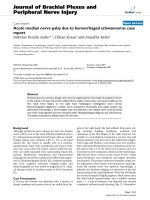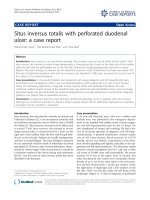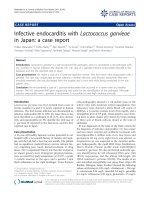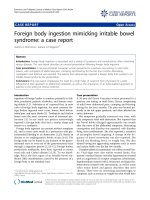Báo cáo y học: " Dicephalus parapagus conjoined twins discordant for anencephaly: a case report" ppt
Bạn đang xem bản rút gọn của tài liệu. Xem và tải ngay bản đầy đủ của tài liệu tại đây (329.56 KB, 4 trang )
CAS E REP O R T Open Access
Dicephalus parapagus conjoined twins discordant
for anencephaly: a case report
Usang E Usang
1*
, Babatunde J Olasode
2
, Ayi E Archibong
1
, Jacob J Udo
1
, Diana-Abasi U Eduwem
1
Abstract
Introduction: Cases of conjoined twins occur so rarely that it is important to learn as much as possible from each
case.
Case presentation: We present a case of 9-hour-old, female, Nigerian dicephalus parapagus conjoined twins
discordant for anencephaly diagnosed only after the birth of the twins. The anencephalic twin was stillborn while
the normal one died within 9 hours of birth from cardiopulmonary failure.
Conclusion: Many congenital defects of interest can now be detected before birth. A severe lesion such as that
found in our index case, which is incompatible with postnatal life, requires counselling. If detected early enough
during a properly monitored antenatal care, it may indicate termination of pregnancy.
Introduction
Conjoined twinning is a rare phenomenon, occurring in
1 in 50,000 to 100,000. However, sin ce 60% are stillborn
or die shortly after, the true incidence is around 1 in
200,000 live births [1]. A rarer form o f conjoined twin-
ning is the dicephalus parapagus twins discordant for
anencephaly in which the laterally united babies have
two heads in one trunk. One of the twins has no cra-
nium or brain tissue, but both have upper limbs and
two lower limbs. Whereas the incidence of conjoined
twinning in our country is unknown, there have been
previous reports from Nigeria [2].
We recently encountered live dicephalus parapagus
conjoined twins discordant for anencephaly who sur-
vived for 9 hours after delivery.
Case presentation
9-hour-old female conjoined twins wi th one torso and
two heads were brought into the sick babies unit (SBU)
by a 25-year-o ld Nigerian mother of the Ekoi t ribe in
Cross Rivers State who just had her first delivery. She
had limited antenatal care (ANC) in a primary health
centre where no antenatal ultrasonography had been
carried out. The pre gnancy, which was carried to term,
was characterized by regular use of an herbal enema
from the onset and polyhydramnios. The delivery had
been complet ed vagina lly at home without any o bstruc-
tion to labour. The normal head presented first. Only
the n ormal twin cried after several minutes of stimula-
tion. The combined weight of the conjoined twins at the
time of admission was 2.85 kg.
Clinical examination revealed two discordant heads
(Figure 1). The normal and anencephalic heads had an
occipito-frontal circumference of 34 cm and 24 cm,
respectively. There was a single thorax with two neuro-
logically independent upper limbs, single abdomen, one
complement of genitalia a nd an anus as well as two
neurologically independent lower limbs.
At presentation in the SBU, the anencephalic twin was
unresponsive to painful stimulus with dilated and
unreactive pupils. An orogastric tube was inserted that
ended in the neck of the twin.
The normal twin remained stable for a short while but
soon experienced repeate d apneic attacks with cyanosed
extremities. Thoug h prompt resuscitative measures were
taken, the twin died within 9 hours of birth from cardio-
pulmonary failure. As a result of their unstable condi-
tion and the short dur ation of life, thorough
investigation of the twins was not possible.
Post-mortem Babygram findings
Post-mortem plain X-ray findings showed a fully devel-
oped cranium with normal facial structures continuous
with the main body. The second head was devoid of a
* Correspondence:
1
University of Calabar/University of Calabar Teaching Hospital, Calabar, Cross
River State, Nigeria
Usang et al. Journal of Medical Case Reports 2010, 4:38
/>JOURNAL OF MEDICAL
CASE REPORTS
© 2010 Usang et al; licensee BioMed Central Ltd. This is an Open Ac cess artic le distr ibuted unde r the terms of the Creati ve Commons
Attribution License (http:// creativecommons.org/licenses/by/2.0), which permits unrestricted use, distribution, and reproduction in
any medium, provided the original work is pro perly cited.
cranium. Each cranium was connected via a separate
spine that terminated abruptly a t the fifth lumber ver-
tebrae with no evidence of any sacral component (Figure
2). The ribs on the medial s ide of each twin were fused
with each other creating 12 instead of 24 posterior ribs,
but the other ribs h ad not fused. Each upper limb and
clavicle appeared borne by the twin on that side.
The lungs and heart were n ot demonstrable but the
single pelvis and lower limbs are clearly defined.
Autopsy findings
Theheadwithnormalcalvariacontainedawell-formed
brain whereas the anencephalic head had no forebrain.
Two complements of neck organs and two vertebral col-
umns were demonstrable. The right trachea continued
to a right-sided pair of normal lungs while the left tra-
chea joined a pair of colla psed and hypoplastic lungs. A
single intestinal tract opened to the exte rior as a well-
formed anal canal. The other abdominal and pelvic
organs were not duplicated.
Two pairs of g reat vessels (Figure 3; ar rows), two aor-
tic and two superior vena cavae entered the single heart.
Ther e were two atria, two rudimentary auricular appen-
dages and two ventricles.
Discussion
Prenatally diagno sed dicephalus conjoined twins discor-
dant for anencephaly has been reported but is rare [3].
It is also rare for such an anomaly to escape antepartum
diagnosis and only present at birth, as in the case of our
patients, with the current antenatal screening tests car-
ried out in developed countries.
The relationship between conjoined twinning and
anencephaly is not well understood. However, it has
been observed that the incidence of congenital malfor-
mations is significantly increased in conjoined twinning,
probably due to the later incomplete fission of the
monozygotic embryo during embryogenesi s (fissi on the-
ory) or due to secondary union of two originally sepa-
rate monovular embryonic discs (fusion theory) [4]. For
this reason, it is claimed that the same aetiological fac-
tor could be responsible for both the conjoining process
and congenital malformations [5]. Consequently, there is
failure of the neural t ube at the cranial end during the
fourth week of development [6] causing the forebrain
primordium to be abnormal and the development of the
calvaria to be defective. This gives rise to anencephaly
which is a fatal disorder. While 50% of cases result in
fetal demise, the rest die at birth or shortly thereafter as
was the case with our discordant conjoined twins. This
disorder is also associated with a high risk of preterm
delivery before 32 weeks due to the development of
polyhydramnios [7], possibly due to the f etuses lacking
the neural control necessary for swallowing amniotic
Figure 1 The conjoined twins with discordant heads.
Figure 2 A plain X-ray of the twins showing two separate
spines.
Figure 3 The twins’ single heart with paired great vessels
(arrows).
Usang et al. Journal of Medical Case Reports 2010, 4:38
/>Page 2 of 4
fluid. This is probably responsible for the few reported
cases of the anomaly in the literature.
Spitz [8], in a study of conjoined twins, concluded that
one third of those born alive have severe defects for
which surgery is not possible. Similarly, Golladay et al .
[9] observed that surgical separation is feasible only
when the upper portions of the trunks are s ufficiently
separate to provide a stable rib cage for each infant. We
agree with these authors because the clinical, radiologic
and morbid study of our twins showed that separation
was impossible. In the case of monozygotic twins discor-
dant for anencephaly, selective termination by occlusion
of the umbilical vessels of the abnormal fetus [10]
would be the optimal management for the future. This
prevents transplacental passage of injurious agents
through the common placenta to the normal co-twin,
which would occur if this selective termination was
achieved by intracardiac injection of potassium chloride
[11].
However, when twins are conjoined, as in the c ase of
our patients, they not o nly share one placenta but have
a single umbilical cord through which umbilical vessels
are shared [12], therefore selective termination is impos-
sible. We therefore agree with Owolabi et al.[13]that
termination of pregnancy should be advised in cases
where dicephalic twins are detecte d early in utero,espe-
cially if there is discordance for anencephaly as in the
case of our patients.
Screening the serum of pregnant women at 16 to 18
weeks’ gestation for alpha-fetoprotein can result in the
detection of about 80% of fetuses with anencephaly and
other neural tube defects [14]. If a woman has a high
alpha-fetoprotein level , ultrasonography is performed to
determine whether an abnormality is present. With the
advent of high resolution ultrasonography, conjoined
twins can be picked up as early as the 8th week of
gestation and with fetal echocardiography as well as
ultra fast magnetic resonance imaging, evaluated for
possibility of postnatal survival [15].
However, most of these facilities are lacking in many
of our country’ s institutions. Moreover, many of the
patients do not register for ANC due to poverty and
being ill-informed, as in our index case. As a result, pre-
natal diagnosis of congenital anomalies is unlikely in our
region.
Conclusion
This case emphasizes the need for ANC with prenatal
ultrasound monitoring of high-risk pregnancies in order
to determine t he nature of the perinatal management
required. W hen serious malformations that are incom-
patible with postnatal life are diagnosed early enough,
the family has the option of terminating the pregnancy.
Therefore, there is a need to improve our health care
delivery system to make such services available and
accessible to all our pregn ant women. Similarly, it is
important to educate the women and their spouses on
the need for proper ANC.
Consent
Written informed consent was obtained from the par-
ents for the publication of t his case report and any
accompanying images. A copy of the written consent is
available for review by the journal’s Editor-in-Chief.
Abbreviations
ANC: antenatal care; SBU: sick babies unit.
Acknowledgements
The authors appreciate the contributions of the resident doctors and
nursing staff of the paediatric surgery unit in the care of these twins during
their short lives.
Author details
1
University of Calabar/University of Calabar Teaching Hospital, Calabar, Cross
River State, Nigeria.
2
Obafemi Awolowo University/Obafemi Awolowo
University Teaching Hospitals Complex, Ile Ife, Osun State, Nigeria.
Authors’ contributions
UEU drafted the manuscript. BJO performed the autopsy and also joined in
drafting the manuscript. AEA and JJU supervised treatment and drafting of
the manuscript. DUE reported on the post-mortem radiologic findings and
helped to draft the manuscript. All authors have read and approved the final
manuscript.
Competing interests
The authors declare that they have no competing interests.
Received: 5 November 2009
Accepted: 5 February 2010 Published: 5 February 2010
References
1. Spitz L, Kiely EM: Experience in the management of conjoined twins. Br J
Surg 2002, 89:1188-1192.
2. Omokhodion SI, Ladipo JK, Odebode TO, Ajao OG, Famewo CE,
Lagundoye SB, Sanusi A, Gbadegesin RA: The Ibadan conjoined twins: a
report of omphalopagus twins and a review of cases reported in Nigeria
over 60 years. Ann Trop Pediatr 2001, 21:263-270.
3. Chatkupt S, Chatkupt S, Kohut G, Chervenak FA: Antepartum diagnosis of
discordant anencephaly in dicephalic conjoined twins. J Clin Ultrasound
1993, 21(2):138-142.
4. Spencer R: Theoretical and analytical embryology of conjoined twins,
part 1: embryogenesis. Clin Anat 2000, 13(1):36-53.
5. Scinzed AA, Smith DW, Miller JR: Monozygotic twinning and structural
defects. J Pediatr 1979, 95:921-930.
6. Nakatsu T, Uwabe C, Shiota K: Neural tube closure in humans initiates at
multiple sites: evidence from human embryos and implications for the
pathogenesis of neural tube defects. Anat Embryol 2000, 201(6):455-466.
7. Guha-Ray DK: Obstetric problems in association with anencephaly. A
survey of 60 cases. Obstet Gynecol 1975, 46:569-572.
8. Spitz L: Conjoined twins. Br J Surg 1996, 83:1028-1030.
9. Golladay ES, Williams GD, Seibert JJ, Dungan WT, Shenefelt R: Dicephalus
dipus conjoined twins: A surgical separation and review of previously
reported cases. J Pediatr Surg 1982, 17(3):259-263.
10. Evans MI, Goldberg JD, Dommergues M, Wapner RJ, Lynch L, Dock BS,
Horenstein J, Golbus MS, Rodeck CH, Dumez Y, Holzgreve W, Timor-Tritsh
Ijohnson MP, Isada NB, Monteagudo A, Berkowitz L: Efficacy of second-
trimester selective termination for fetal abnormalities: international
collaborative experience among the World’s largest centers. Am J Obstet
Gynecol 1994, 171:90-94.
Usang et al. Journal of Medical Case Reports 2010, 4:38
/>Page 3 of 4
11. Evans MI, May M, Drugan A, Fletcher JC, Johnson MP, Sokol RJ: Selective
termination: clinical experience and residual risks. Am J Obstet Gynecol
1990, 162:1568-1575.
12. Shah DS, Tomar GP, Prajapati H: Conjoined twins - Report of two cases.
Indian J Radiol Imaging 2006, 16:199-201.
13. Owolobi AT, Oseni SB, Sowande OA, Adejuyigbe O, Komolafe EO,
Adetiloye VA, Komolafe A: Dicephalus dibrachius dipus conjoined twins in
a triplet pregnancy. Trop J Obstet Gynaecol 2005, 22:87-88.
14. Wald JN, Chuckle HS: Alpha-fetoprotein in the antenatal diagnosis of
open neural tube defects. Br J Hosp Med 1980, 23:473-489.
15. Goldberg Y, Ben-Shlomo I, Weiner E, Shalev E: First trimester diagnosis of
conjoined twins in a triplet pregnancy after IVF and ICSI. Hum Reprod
2000, 5(6):1413-1415.
doi:10.1186/1752-1947-4-38
Cite this article as: Usang et al.: Dicephalus parapagus conjoined twins
discordant for anencephaly: a case report. Journal of Medical Case Reports
2010 4:38.
Submit your next manuscript to BioMed Central
and take full advantage of:
• Convenient online submission
• Thorough peer review
• No space constraints or color figure charges
• Immediate publication on acceptance
• Inclusion in PubMed, CAS, Scopus and Google Scholar
• Research which is freely available for redistribution
Submit your manuscript at
www.biomedcentral.com/submit
Usang et al. Journal of Medical Case Reports 2010, 4:38
/>Page 4 of 4









